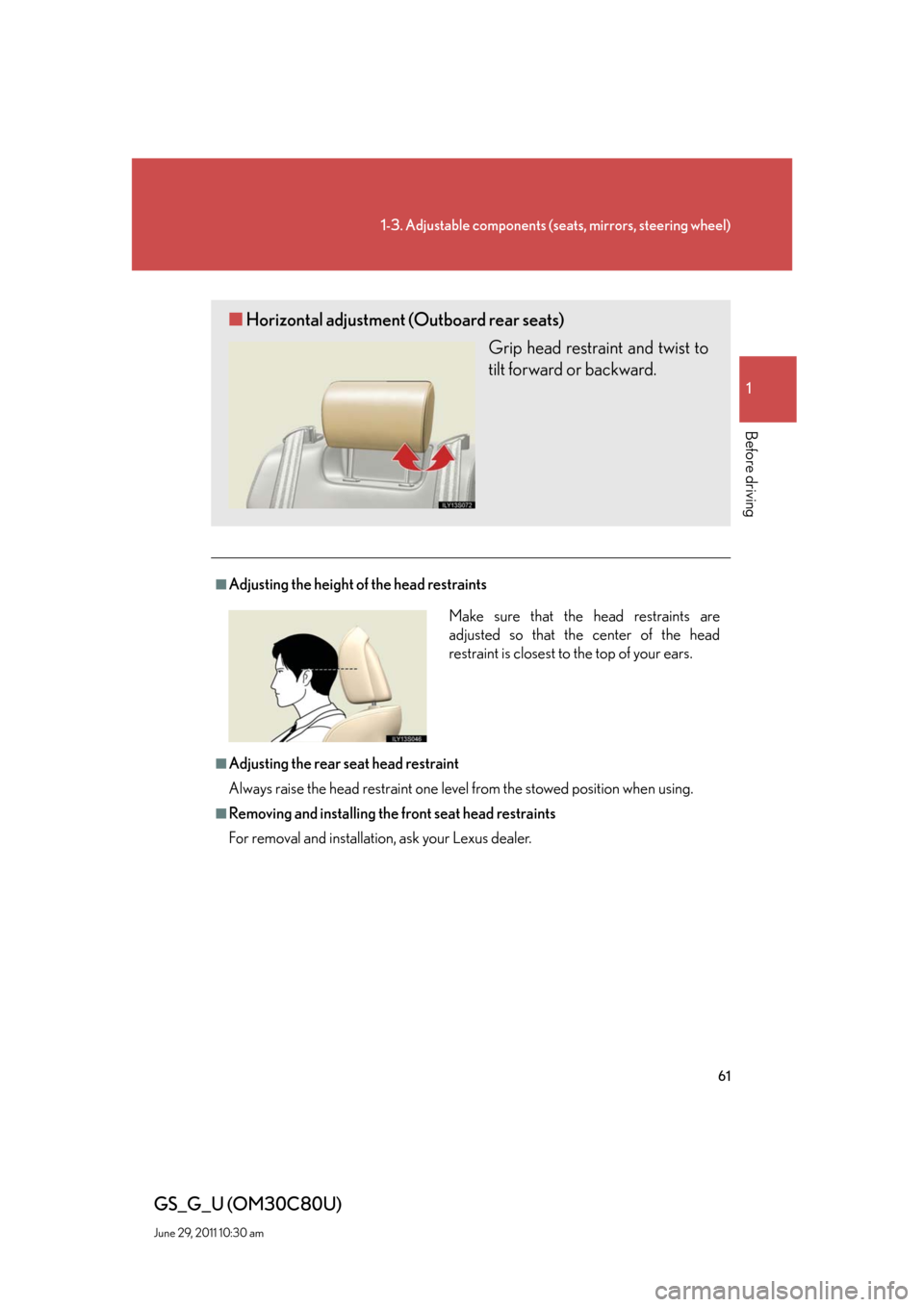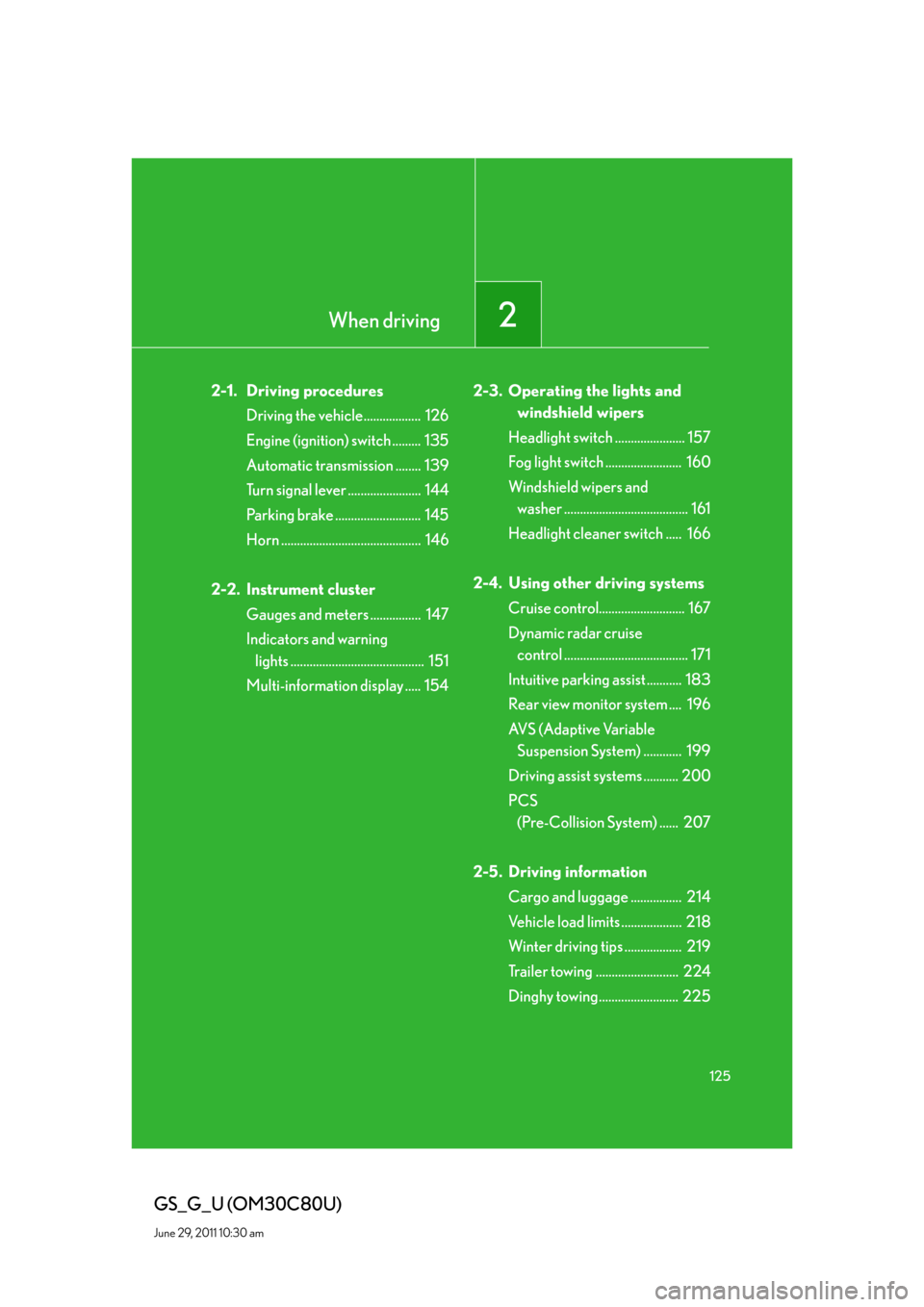tow Lexus GS350 2010 Using The Audio System / LEXUS 2010 GS460 GS350 OWNERS MANUAL (OM30C80U)
[x] Cancel search | Manufacturer: LEXUS, Model Year: 2010, Model line: GS350, Model: Lexus GS350 2010Pages: 648, PDF Size: 15.57 MB
Page 1 of 648

TABLE OF CONTENTS
1
GS_G_U (OM30C80U)
June 29, 2011 10:30 am
1Before drivingAdjusting and operating features such as door locks, mir-
rors, and steering column
2When drivingDriving, stopping and safe-driving information
3Interior featuresAir conditioning and audio systems, as well as other interior
features for a comfortable driving experience
4Maintenance
and careCleaning and protecting your vehicle, performing do-it-your-
self maintenance, and maintenance information
5When trouble
arisesWhat to do if the vehicle needs to be towed, gets a flat tire,
or is involved in an accident
6Vehicle
specificationsDetailed vehicle information
7For ownersReporting safety defects for US owners and seat belt in-
structions for Canadian owners
IndexAlphabetical listing of information contained in this manual
Page 3 of 648

1
2
3
4
5
6
7
3
GS_G_U (OM30C80U)
June 29, 2011 10:30 am
2-1. Driving procedures
Driving the vehicle ........................ 126
Engine (ignition) switch .............. 135
Automatic transmission.............. 139
Turn signal lever ............................ 144
Parking brake ................................. 145
Horn.................................................... 146
2-2. Instrument cluster
Gauges and meters ..................... 147
Indicators and warning
lights................................................... 151
Multi-information display........... 154
2-3. Operating the lights and
windshield wipers
Headlight switch ............................ 157
Fog light switch .............................. 160
Windshield wipers and
washer............................................... 161
Headlight cleaner switch ........... 1662-4. Using other driving systems
Cruise control ................................. 167
Dynamic radar cruise
control............................................... 171
Intuitive parking assist ................. 183
Rear view monitor system ......... 196
AVS (Adaptive Variable
Suspension System) .................. 199
Driving assist systems................ 200
PCS
(Pre-Collision System) ........... 207
2-5. Driving information
Cargo and luggage ...................... 214
Vehicle load limits......................... 218
Winter driving tips ........................ 219
Trailer towing ................................. 224
Dinghy towing ............................... 225
3-1. Using the touch screen
Touch screen ................................. 228
Setting the touch screen ........... 235
2When driving
3Interior features
Page 5 of 648

1
2
3
4
5
6
7
5
GS_G_U (OM30C80U)
June 29, 2011 10:30 am
4-1. Maintenance and care
Cleaning and protecting
the vehicle exterior.................. 430
Cleaning and protecting
the vehicle interior .................... 433
4-2. Maintenance
Maintenance
requirements............................... 436
General maintenance ............... 438
Emission inspection and
maintenance (I/M)
programs ....................................... 4414-3. Do-it-yourself maintenance
Do-it-yourself service
precautions .................................. 442
Hood ................................................. 445
Positioning a floor jack............... 446
Engine compartment.................. 448
Tires ................................................... 463
Tire inflation pressure................. 473
Wheels ............................................. 477
Air conditioning filter.................. 479
Electronic key battery ................ 482
Checking and replacing
fuses ................................................ 484
Headlight aim ............................... 509
Light bulbs ........................................ 512
5-1. Essential information
Emergency flashers ................... 520
If your vehicle needs
to be towed ................................... 521
If you think something is
wrong ............................................ 530
Fuel pump shut off system ......... 531
Event data recorder.................... 532
4Maintenance and care
5When trouble arises
Page 33 of 648

33
1-2. Opening, closing and locking the doors and trunk
1
Before driving
GS_G_U (OM30C80U)
June 29, 2011 10:30 am
■Operation signals
A buzzer sounds and the emergency flashers flash to indicate that the doors have
been locked/unlocked. (Locked: Once; Unlocked: Twice)
■Conditions affecting operation
The smart access system with push-button start uses weak radio waves. In the fol-
lowing situations, the communication between the electronic key and the vehicle
may be affected, preventing the smart access system with push-button start, wire-
less remote control and immobilizer system from operating properly:
(Way of coping: P. 5 7 1 )
●When the electronic key battery is depleted
●Near a TV tower, electric power plant, gas station, radio station, large display,
airport or other facility that generates strong radio waves or electrical noise
●When carrying a portable radio, cellular phone, cordless phone or other wire-
less communication devices
●When the electronic key is in contact with, or is covered by the following metal-
lic objects
• Cards to which aluminum foil is attached
• Cigarette boxes that have aluminum foil inside
• Metallic wallets or bags
•Coins
• Hand warmers made of metal
• Media such as CDs and DVDs
●When multiple electronic keys are in the vicinity
●When other wireless keys (that emit radio waves) are being used nearby
●When carrying or using the electronic key together with the following devices
that emit radio waves
• Another vehicle’s electronic key or a wireless key that emits radio waves
• Personal computers or personal digital assistants (PDAs)
• Digital audio players
• Portable game systems
●If window tint with a metallic content or metallic objects are attached to the rear
window
Page 61 of 648

61
1-3. Adjustable components (seats, mirrors, steering wheel)
1
Before driving
GS_G_U (OM30C80U)
June 29, 2011 10:30 am
■Adjusting the height of the head restraints
■Adjusting the rear seat head restraint
Always raise the head restraint one level from the stowed position when using.
■Removing and installing the front seat head restraints
For removal and installation, ask your Lexus dealer.
■Horizontal adjustment (Outboard rear seats)
Grip head restraint and twist to
tilt forward or backward.
Make sure that the head restraints are
adjusted so that the center of the head
restraint is closest to the top of your ears.
Page 70 of 648

70
1-3. Adjustable components (seats, mirrors, steering wheel)
GS_G_U (OM30C80U)
June 29, 2011 10:30 am
Steering wheel
Auto tilt away and auto return
When the “ENGINE START
STOP” switch is turned OFF, the
steering wheel returns to its
stowed position by moving up and
away to enable easier driver entry
and exit.
Switching to ACCESSORY or
IGNITION ON mode will return
the steering wheel to the original
position.
The steering wheel can be adjusted to a comfortable position while the
“ENGINE START STOP” switch is in ACCESSORY or IGNITION ON
mode.
Up
Down
Toward the driver
Away from the driver
CAUTION
■While driving
Do not adjust the steering wheel.
Doing so may cause the driver to mishandle the vehicle and an accident, resulting in
death or serious injury.
Page 100 of 648

100
1-7. Safety information
GS_G_U (OM30C80U)
June 29, 2011 10:30 am
CAUTION
■SRS airbag precautions
Observe the following precautions regarding the airbags. Failure to do so may
cause death or serious injury.
●The driver and all passengers in the vehicle must wear their seat belts properly.
The SRS airbags are supplemental devices to be used with the seat belts.
●The SRS driver airbag deploys with considerable force, and can cause death or
serious injury especially if the driver is very close to the airbag. The National
Highway Traffic Safety Administration (“NHTSA”) advises:
Since the risk zone for driver airbag is the first 2 - 3 in. (50 - 75 mm) of inflation,
placing yourself 10 in. (250 mm) from your driver airbag provides you with a
clear margin of safety. This distance is measured from the center of the steering
wheel to your breastbone. If you sit less than 10 in. (250 mm) away now, you can
change your driving position in several ways:
• Move your seat to the rear as far as you can while still reaching the pedals
comfortably.
• Slightly recline the back of the seat. Although vehicle designs vary, many driv-
ers can achieve the 10 in. (250 mm) distance, even with the driver seat all the
way forward, simply by reclining the back of the seat somewhat. If reclining
the back of your seat makes it hard to see the road, raise yourself by using a
firm, non-slippery cushion, or raise the seat if your vehicle has that feature.
• If your steering wheel is adjustable, tilt it downward. This points the airbag
toward your chest instead of your head and neck.
The seat should be adjusted as recommended by NHTSA above, while still main-
taining control of the foot pedals, steering wheel, and your view of the instrument
panel controls.
Page 102 of 648

102
1-7. Safety information
GS_G_U (OM30C80U)
June 29, 2011 10:30 am
CAUTION
■SRS airbag precautions
●Do not sit on the edge of the seat or lean
against the dashboard.
●Do not allow a child to stand in front of the
SRS front passenger airbag unit or sit on
the knees of a front passenger.
●Do not drive the vehicle while the driver or
passenger have items resting on their
knees.
●Do not lean against the door, the roof side
rail or the front, side and rear pillars.
●Do not allow anyone to kneel on the pas-
senger seat toward the door or put their
head or hands outside the vehicle.
Page 125 of 648

When driving2
125
GS_G_U (OM30C80U)
June 29, 2011 10:30 am
2-1. Driving procedures
Driving the vehicle.................. 126
Engine (ignition) switch ......... 135
Automatic transmission ........ 139
Turn signal lever ....................... 144
Parking brake ........................... 145
Horn ............................................ 146
2-2. Instrument cluster
Gauges and meters ................ 147
Indicators and warning
lights .......................................... 151
Multi-information display ..... 1542-3. Operating the lights and
windshield wipers
Headlight switch ...................... 157
Fog light switch ........................ 160
Windshield wipers and
washer ....................................... 161
Headlight cleaner switch ..... 166
2-4. Using other driving systems
Cruise control........................... 167
Dynamic radar cruise
control ....................................... 171
Intuitive parking assist ........... 183
Rear view monitor system .... 196
AVS (Adaptive Variable
Suspension System) ............ 199
Driving assist systems ........... 200
PCS
(Pre-Collision System) ...... 207
2-5. Driving information
Cargo and luggage ................ 214
Vehicle load limits ................... 218
Winter driving tips .................. 219
Trailer towing .......................... 224
Dinghy towing......................... 225
Page 142 of 648

142
2-1. Driving procedures
GS_G_U (OM30C80U)
June 29, 2011 10:30 am
■Shift ranges and their functions
●You can choose from 8 levels (GS460) or 6 levels (GS350) of
engine braking force.
●A lower shift range will provide greater engine braking force than a
higher shift range, and the engine revolutions will also increase.
●If you accelerate while in ranges “1” to “7” (GS460) or “1” to “5”
(GS350), the shift range may automatically range up in accordance
with the vehicle’s speed.
●A higher shift range is automatically selected when the automatic
transmission fluid temperature is high.
■“S” mode
●When the shift range is “6” (GS460) or “4” (GS350) or lower, holding the shift
lever toward “+” sets the shift range to “8” (GS460) or “6” (GS350).
●To prevent the engine from over-revving, upshifting may automatically occur.
■Downshifting restrictions warning buzzer (in the “S” mode)
To help ensure safety and driving performance, downshifting operation may some-
times be restricted. In some circumstances, downshifting may not be possible even
when the shift lever is operated. (The warning buzzer will sound twice.)
■When driving with the cruise control system (or dynamic radar cruise control sys-
tem)
The engine brake will not operate in the “S” mode, even when downshifting to “7”,
“6”, “5” or “4” (GS460) or “5” or “4” (GS350). (P. 167, 171)
■Snow mode automatic deactivation
Snow mode is automatically deactivated if the “ENGINE START STOP” switch is
turned to ACCESSORY or IGNITION ON mode after driving in snow mode.
■If the shift lever cannot be shifted from “P”
P. 5 6 9